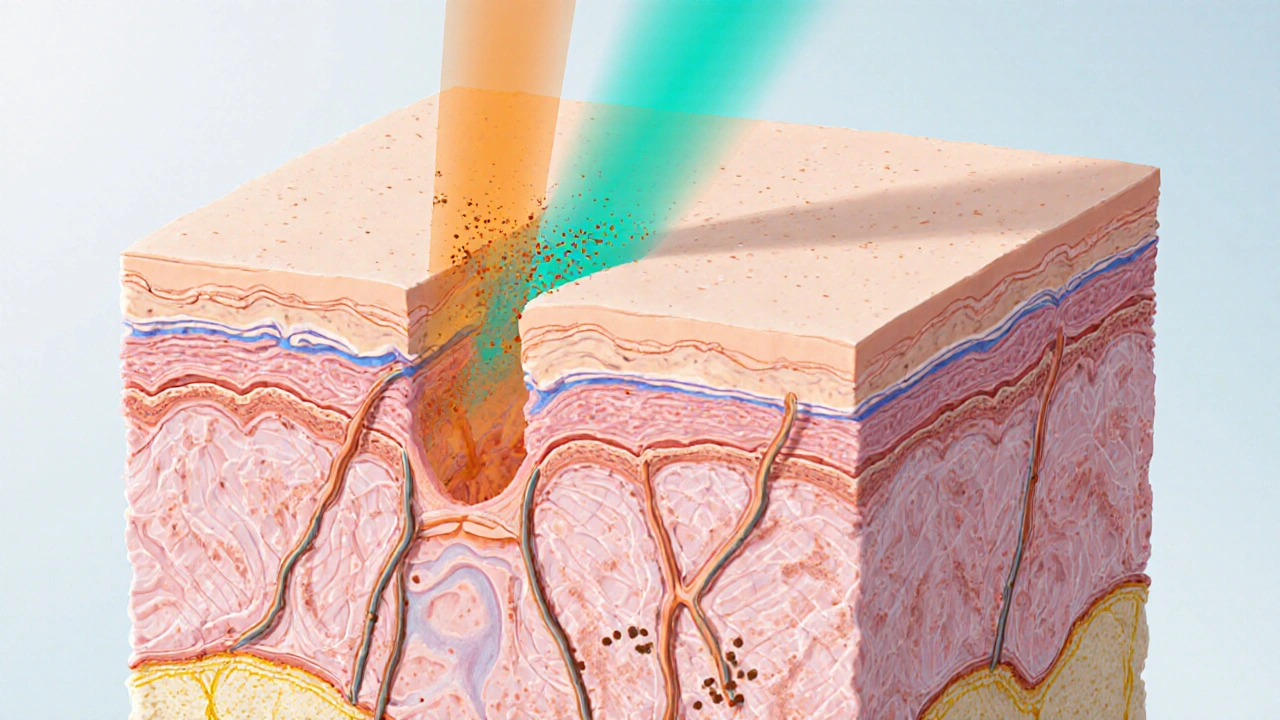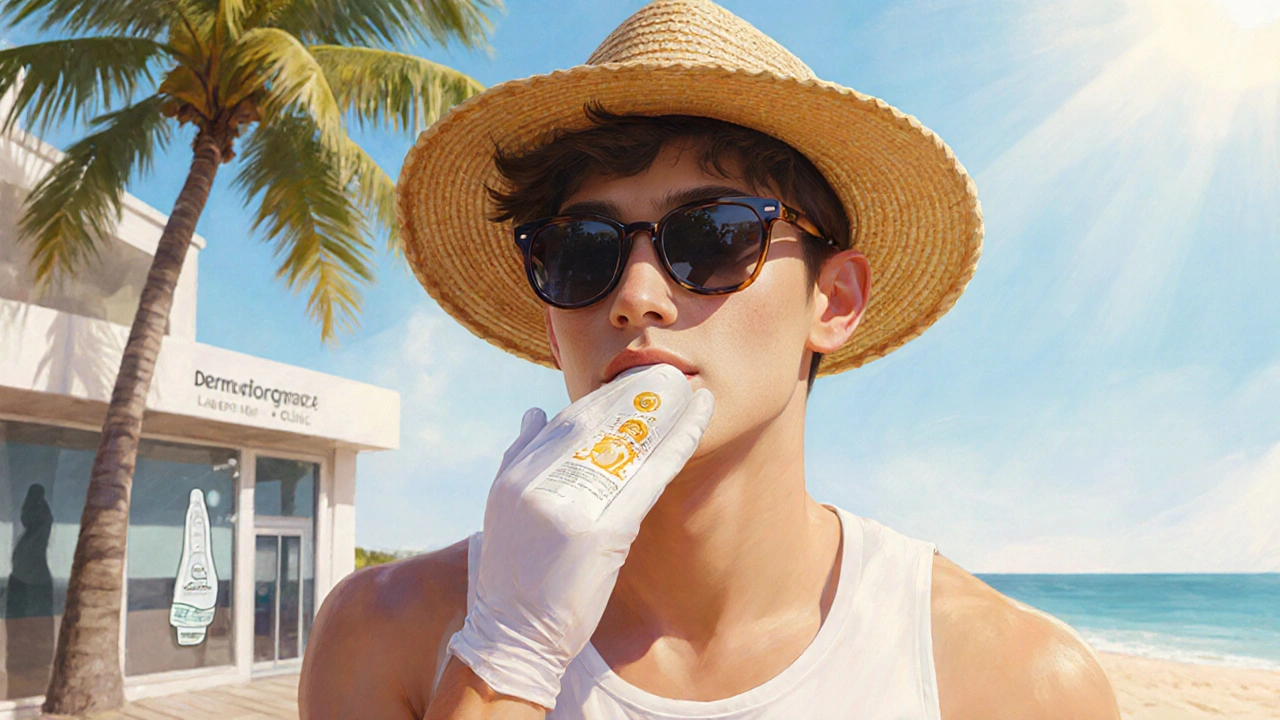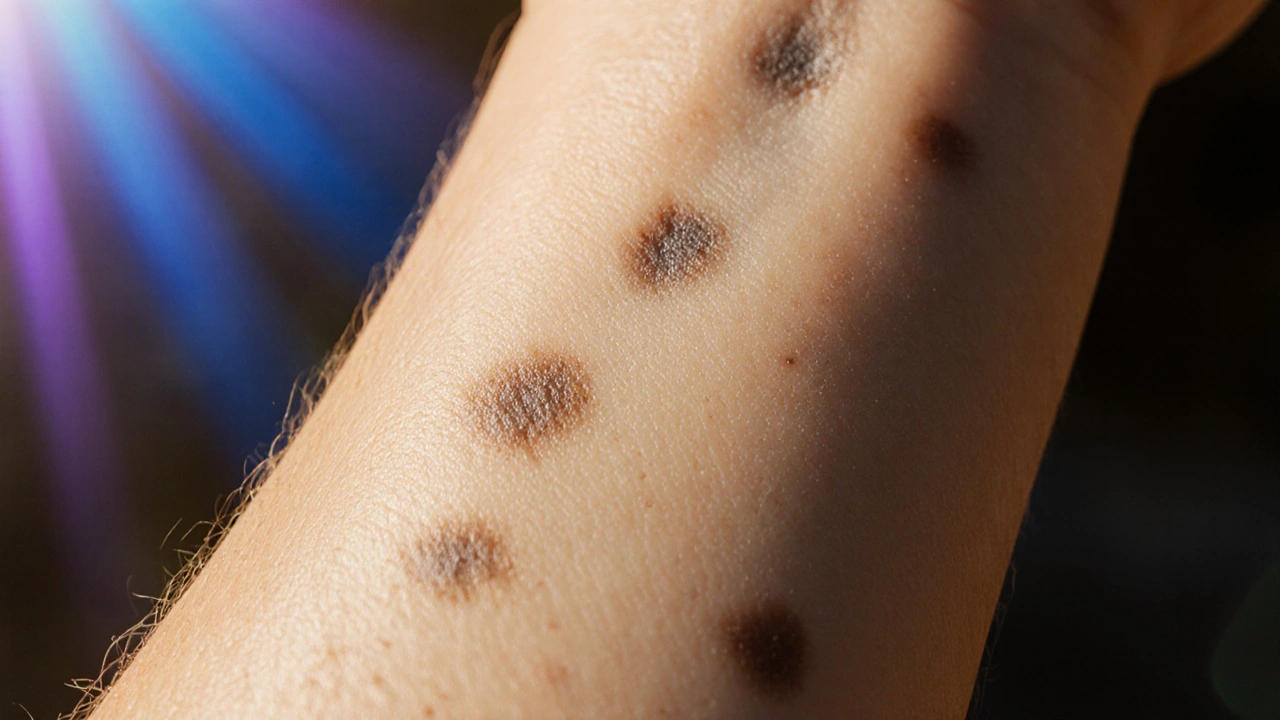Age Spot Prevention Calculator
Enter your details and click calculate to assess your risk of developing age spots.
Ever notice those dark freckles that seem to appear out of nowhere on your hands or face? Most of the time they’re not random - they’re a direct signal from your skin that it’s been soaking up too much sunlight. Understanding why those patches show up, what they really mean, and how you can keep them at bay is the first step toward clearer, healthier skin.
TL;DR
- Age spots are flat, brown‑gray patches that form when UV rays boost melanin production.
- UV‑A penetrates deep and drives long‑term pigment changes; UV‑B triggers sunburn and accelerates spot formation.
- Daily broad‑spectrum sunscreen (SPF30+) plus protective clothing cuts spot risk by up to 70%.
- Topical brighteners, chemical peels, and laser therapy can fade existing spots safely.
Age spots are flat, hyperpigmented lesions that typically appear on sun‑exposed skin after the age of 40
Most people call them “liver spots” or “solar lentigines,” but the name isn’t as important as what they signal. Age spots are clusters of melanin that have settled deeper in the epidermis and sometimes the upper dermis. Unlike freckles, which flare up with each sunburst, age spots stay put and tend to grow slowly over months or years.
Because they are a sign of cumulative UV damage, spotting them early can help you catch the need for stricter sun protection before more serious issues, like skin cancer, arise.
How Sun Exposure Triggers Age Spots
When your skin meets sun exposure the amount of ultraviolet (UV) radiation reaching the skin’s surface, a cascade of biochemical events starts. UV photons energize skin cells, prompting them to produce more melanin the pigment that gives skin its color and helps absorb UV radiation as a natural defense.
Normally, melanin stays in the basal layer of the epidermis and is evenly distributed. Excessive or chronic UV exposure overwhelms this balance, causing melanin‑laden cells (melanocytes) to migrate deeper and cluster together. Over time, these clusters darken and become the visible age spots you see.
Two main types of UV light are at work here, and each leaves a different fingerprint on your skin.
Types of UV Radiation and Their Impact
UV‑A (320‑400nm) penetrates the deepest layers of skin, reaching the dermis where collagen lives. It doesn’t cause the immediate burn of UV‑B, but it accelerates the breakdown of collagen and stimulates melanin production over the long haul. This deep penetration is the prime driver of age‑spot formation and photo‑aging.
UV‑B (280‑320nm) is the chief culprit behind sunburn. It primarily affects the outer epidermis, triggering inflammation and DNA damage. While UV‑B’s damage is more acute, repeated burns create a “reset” in melanin production that can lead to clusters forming faster.
Both rays are present in everyday sunlight, which is why broad‑spectrum protection matters.

Other Risk Factors That Help Age Spots Appear
Sunlight isn’t the only player. Age itself reduces the skin’s ability to repair DNA, so older skin is more vulnerable. Fair skin types (Fitzpatrick I‑II) have less natural melanin and therefore need more protection. Hormonal changes - such as those during pregnancy or from oral contraceptives - can also boost pigment production, making spots appear more quickly.
Genetics matter too. If your parents have a history of early‑onset age spots, you’re more likely to develop them at a younger age.
Prevention Strategies That Actually Work
Stopping age spots before they start is far easier than trying to erase them later. The cornerstone is consistent, broad‑spectrum sunscreen a topical product that absorbs or reflects ultraviolet radiation. But not all sunscreens are created equal.
| Type | UV Protection | Typical SPF Range | Water Resistance | Best For |
|---|---|---|---|---|
| Chemical (e.g., avobenzone) | Absorbs UV‑A & UV‑B | 15‑50 | 40min | Everyday use, lightweight feel |
| Mineral / Physical (zinc oxide, titanium dioxide) | Reflects UV‑A & UV‑B | 30‑70 | 80min | Sensitive skin, outdoor sports |
| Hybrid (mix of chemical & mineral) | Broad‑spectrum, balanced | 30‑50 | 60min | Those who want minimal white cast |
For most people, a daily SPF30+ broad‑spectrum sunscreen applied 15minutes before stepping outside is enough to cut spot formation by roughly two‑thirds. Reapply every two hours when you’re outdoors, and after swimming or sweating.
Other habits matter:
- Wear wide‑brim hats, UV‑protective sunglasses, and tightly‑woven UPF clothing.
- Seek shade between 10a.m. and 4p.m., when UV‑A peaks.
- Include antioxidants like vitaminC serum in your routine - they neutralize free radicals caused by UV‑A.
Treatment Options for Existing Age Spots
Even with perfect prevention, some spots may already be present. Fortunately, modern skin‑care offers several gentle, effective ways to fade them.
Topical Brighteners: Products containing hydroquinone, niacinamide, or kojic acid slow melanin production and gently lighten spots over 8‑12 weeks.
Chemical Peels: Glycolic or trichloroacetic acid peels remove the top layer of pigmented skin, revealing fresher tissue underneath. Typically three to five sessions spaced a month apart achieve noticeable results.
Laser & Light Therapy: Fractional lasers target melanin cells directly, breaking down pigment while sparing surrounding tissue. A board‑certified dermatologist a medical doctor specialized in skin health and treatment can tailor the intensity to your skin type.
Post‑treatment care is crucial: keep the area moisturized, avoid sun for at least two weeks, and continue using sunscreen to prevent recurrence.
Common Myths About Age Spots and Sun
Myth 1: “If I get a tan, the spots will disappear.” - Tanning actually adds more UV‑A exposure, deepening pigment and creating new spots.
Myth 2: “Only outdoor workers need sunscreen.” - Even brief, daily exposure through windows or during a quick walk contributes to cumulative damage.
Myth 3: “Natural oils protect my skin.” - While oil can provide a barrier against moisture loss, it does nothing to block UV rays.
Quick Checklist to Keep Age Spots at Bay
- Apply SPF30+ broad‑spectrum sunscreen every morning.
- Reapply sunscreen every 2hours outdoors.
- Wear UPF clothing, hats, and sunglasses during peak sun hours.
- Use a vitaminC serum or antioxidant moisturizer.
- Schedule an annual skin exam with a dermatologist.

Frequently Asked Questions
Can age spots turn into skin cancer?
Age spots themselves are benign, but they indicate extensive sun damage. If a spot changes color, becomes irregular, or starts to bleed, see a dermatologist promptly, as these could be signs of melanoma or other skin cancers.
How long does it take for sunscreen to prevent a new spot?
Consistent daily use builds a protective layer that reduces new pigment formation within a few weeks. Visible results often appear after 1‑2months of diligent sun protection.
Are home remedies like lemon juice effective?
Lemon juice is highly acidic and can irritate skin, worsening hyperpigmentation. Professional treatments and proven topical agents are safer and more reliable.
Should I use a higher SPF than 30?
SPF30 blocks about 97% of UV‑B rays; SPF50 blocks about 98%. The incremental benefit is small, so focus on broad‑spectrum coverage, proper amount (about a nickel‑size dollop for the face), and reapplication instead of chasing higher numbers.
Do indoor lights cause age spots?
Standard indoor lighting emits negligible UV‑A or UV‑B, so it’s not a major factor. However, some fluorescent tubes and LEDs can emit low‑level UVA; using UV‑filtering bulbs can further minimize risk.

Anthony Coppedge
October 1, 2025 AT 18:38